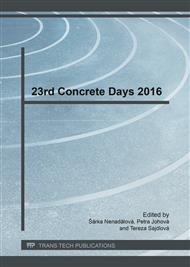p.64
p.70
p.75
p.80
p.85
p.90
p.97
p.101
p.106
Residual Material Properties of High Strength Fibre Reinforced Concrete Exposed to Elevated Temperatures
Abstract:
This paper is focused on the research of material characteristics of high performance concrete reinforced with a combination of steel and hybrid fibers exposed to the extreme temperatures. In the performed experiments it was examined several types of mixtures (HPFRC, UHPFRC) exposed to the extreme temperatures up to 200-1200 °C. Outside residual parameters of each examined mixtures (tensile bending strength, compression strength, fracture parameters) was investigated the dependence of porosity of the matrix, sample damage and chemical analysis of samples exposed to extreme temperatures, to the resulting mechanical parameters. Part of the initial results of the research described base material and physical properties of the examined mixes and shows the effect of high temperatures on these properties. The results presented in the current paper are the basis for further research and the preparation of numerical models for the design of HPC exposed to extreme temperatures.
Info:
Periodical:
Pages:
85-89
Citation:
Online since:
May 2017
Authors:
Keywords:
Price:
Сopyright:
© 2017 Trans Tech Publications Ltd. All Rights Reserved
Share:
Citation:


